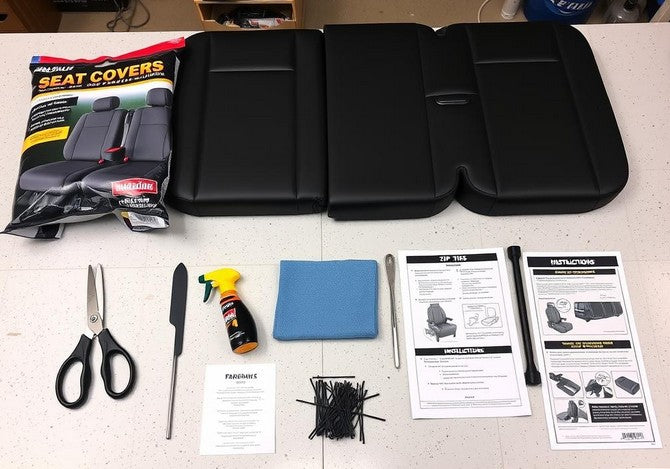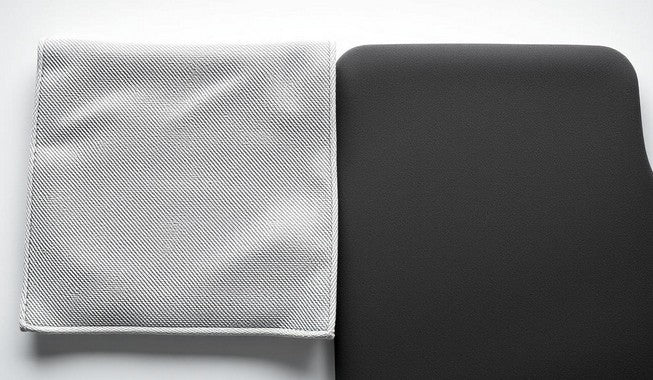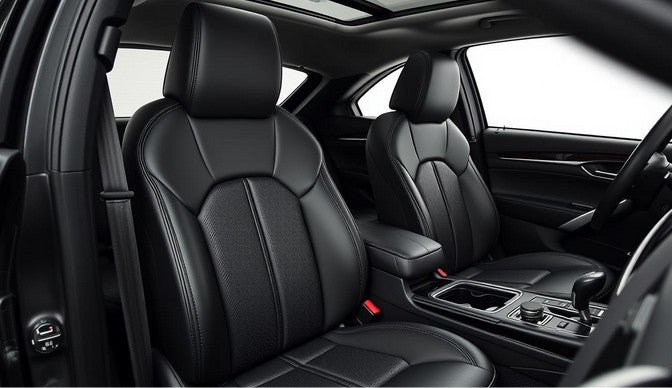Installing custom seat covers in your truck is one of the smartest investments you can make to protect your interior and enhance your vehicle's appearance. With the right approach, you can achieve professional-looking results without paying for installation. This comprehensive guide walks you through the entire process of installing custom seat covers specifically designed for trucks, addressing common challenges and ensuring a perfect fit that will last for years.
Why Install Custom Seat Covers for Your Truck?
Before diving into the installation process, it's worth understanding why custom seat covers are particularly valuable for truck owners:
Protection Benefits
- Shields against dirt, mud, and debris common in work trucks
- Prevents wear and tear from frequent entry/exit
- Protects against UV damage and fading
- Resists stains from spills, food, and beverages
- Prevents damage from tools and equipment
Aesthetic & Practical Benefits
- Customizes your truck's interior appearance
- Covers existing damage or worn factory upholstery
- Increases resale value by preserving original seats
- Provides additional comfort with padded options
- Offers easy cleaning and maintenance
Ready to Protect Your Truck's Interior?
Custom-fit seat covers provide superior protection and appearance compared to universal options. Find the perfect seat covers designed specifically for your truck model.
Tools and Materials You'll Need
Gathering the right tools before you begin will make the installation process much smoother. Here's everything you'll need to install custom seat covers for your truck:
Essential Tools
- Custom seat covers specifically designed for your truck model
- Trim removal tool for safely prying plastic trim pieces
- Scissors for trimming excess material if necessary
- Flat-head screwdriver for tucking fabric and securing attachments
- Spray cleaner and microfiber cloth for preparing seats
Optional But Helpful
- Zip ties for additional securing if needed
- Vacuum cleaner for thorough seat preparation
- Fabric brush for smoothing out wrinkles
- Small flashlight for seeing under seats
- Helper for managing larger pieces
Pro Tip: Quality matters when it comes to custom truck seat covers. Look for heavy-duty materials like neoprene, Cordura, or ballistic nylon that can withstand the demands of truck use. Avoid universal "one-size-fits-all" covers as they rarely provide a proper fit for truck seats.
Get Truck-Specific Seat Covers
For the best results, choose seat covers designed specifically for your truck's make, model, and year. Custom-fit covers account for all seat features including airbags, controls, and unique contours.
Preparation Steps Before Installation
Proper preparation is crucial for achieving a professional-looking installation. Follow these steps before attempting to install your custom seat covers:
1. Check Compatibility
Verify that your seat covers are designed specifically for your truck's make, model, and year. Check that all pieces are accounted for in the package, including any headrest covers, armrest covers, and installation hardware.
2. Clean and Prepare the Seats
Thoroughly clean your truck's seats before installation. This ensures no dirt or debris gets trapped underneath the covers and prevents potential damage to both the original upholstery and the new covers.
- Vacuum all seats thoroughly, paying special attention to seams and crevices
- Wipe down seats with appropriate cleaner (leather cleaner for leather, fabric cleaner for cloth)
- Allow seats to dry completely before installation
- Remove any personal items from seat pockets and compartments
3. Adjust Seat Position
Position your truck seats for optimal installation access:
- Move front seats all the way back and recline them slightly
- For rear bench seats, fold down any folding sections
- Remove headrests if possible (consult your truck's manual if unsure)
- Disconnect seat battery if your truck has powered/heated seats (optional safety precaution)
Important Safety Note: If your truck has side airbags in the seats, ensure your custom seat covers are specifically designed to accommodate them. Improper installation over airbag areas can interfere with deployment in an accident.
Installing Custom Seat Covers on Front Truck Seats
Front seats in trucks often have unique features like integrated seat belts, side airbags, and electronic controls. Follow these detailed steps for a perfect installation:
Step 1: Install the Seat Bottom Cover
- Identify the correct cover for the seat bottom (usually labeled)
- Slide the cover over the front of the seat cushion, aligning the seams with the seat edges
- Push the rear flap of the cover between the seat back and seat bottom
- Feed the straps or hooks between the seat and center console on one side and between the seat and door on the other
- Pull the straps under the seat and connect them, ensuring they're tight but not straining
- Smooth out any wrinkles and adjust the cover for proper alignment
Step 2: Install the Seat Back Cover
- Remove headrests if you haven't already (usually by pressing release buttons at the base)
- Slide the seat back cover over the top of the seat, ensuring any airbag tags align with the seat's airbag location
- Pull the cover down firmly, working from top to bottom
- Feed any straps or hooks through the gap between the seat back and bottom
- Connect the straps underneath or behind the seat according to the instructions
- For seats with side airbags, ensure the airbag seam aligns perfectly with the airbag location
Step 3: Install Headrest Covers
- Identify the correct headrest covers for your front seats
- Stretch the cover over the headrest, starting from the top
- Pull down firmly to cover the entire headrest
- Secure any straps or elastic bands underneath
- Reattach the headrest to the seat, ensuring it locks securely in place
Truck-Specific Tip: Many trucks have larger, more contoured front seats than cars. Take your time stretching the cover material over these larger surfaces, and don't be afraid to use significant force to achieve a tight fit. The material is designed to stretch without tearing.
Installing Custom Seat Covers on Rear Truck Seats
Rear seats in trucks present unique challenges, especially with split-fold functionality and seat belt placement. Here's how to tackle them:
For Split-Bench Rear Seats (60/40 or 40/20/40)
- Identify which covers correspond to each section of the split bench
- Install each section separately, starting with the seat bottom:
- Slide the cover over the seat cushion
- Tuck the rear flap between the seat back and bottom
- Secure straps underneath the seat
For the seat backs:
- Lower or fold down the seat backs if possible for easier access
- Slide covers over each section from the top
- Pull down firmly and secure at the bottom
- Ensure any split-fold functionality remains operational
For Full-Bench Rear Seats
- Place the seat bottom cover over the entire bench, aligning seams
- Tuck the rear flap between the seat back and bottom
- Feed straps underneath and secure tightly
- Install the seat back cover from top to bottom
- Secure all straps and attachments
Seat Belt Consideration: Truck rear seats often have seat belts that emerge from the seat back rather than the vehicle's frame. Ensure your custom covers have appropriate openings for these seat belts, and take care to feed the belts through properly during installation.
Troubleshooting Common Installation Issues
Even with high-quality custom seat covers, you might encounter some challenges during installation. Here's how to address the most common issues:
Wrinkles and Bunching
Problem: Cover appears wrinkled or bunched in certain areas.
Solution:
- Ensure straps are pulled as tight as possible
- Readjust the cover alignment with the seat's contours
- Work systematically from the center outward, smoothing material
- For persistent wrinkles, try using a hair dryer on low heat to slightly warm the material, making it more pliable
Misalignment Issues
Problem: Cover doesn't align with seat features (controls, levers, etc.)
Solution:
- Double-check you're using the correct cover for that specific seat
- Verify the cover is oriented correctly (front/back, top/bottom)
- Loosen all straps and start over, paying careful attention to alignment
- For covers with openings for controls, ensure these align before securing
Fastener Problems
Problem: Straps or hooks won't reach their connection points.
Solution:
- Adjust seat position to create more slack
- Check for obstructions preventing proper routing
- For straps that barely reach, use zip ties as extensions
- Contact the manufacturer if connections are impossible - you may have received incorrect covers
Airbag Concerns
Problem: Uncertainty about airbag compatibility.
Solution:
- Only use covers specifically designed for your truck with airbag compatibility
- Ensure airbag seams align perfectly with the airbag location
- Never use excessive force to stretch material over airbag areas
- If in doubt, consult the seat cover manufacturer
When to Seek Help: If you encounter significant difficulties that these troubleshooting tips don't resolve, contact the seat cover manufacturer's customer service. Many reputable companies offer installation support or can recommend local professionals who can help.
Maintaining Your Custom Truck Seat Covers
Proper maintenance will extend the life of your custom truck seat covers and keep them looking great for years. Follow these guidelines based on your cover material:
Neoprene Covers
- Spot clean with mild soap and water
- Avoid harsh chemicals or bleach
- Air dry completely before use
- For deeper cleaning, remove covers and hand wash
- Never machine dry
Canvas/Cordura Covers
- Brush off loose dirt regularly
- Spot clean with fabric cleaner
- For stubborn stains, use soft brush
- Some canvas covers are machine washable (check label)
- Air dry only
Leather/Vinyl Covers
- Wipe with damp cloth regularly
- Use leather/vinyl cleaner quarterly
- Apply protectant to prevent cracking
- Clean spills immediately
- Avoid direct sunlight when parked
Maintenance Schedule: For trucks used in demanding conditions (construction, farming, off-roading), inspect your seat covers monthly for any tears or wear. Address small issues immediately before they become larger problems.
Final Installation Checklist and Safety Reminders
Before considering your installation complete, go through this final checklist to ensure everything is properly installed and safe:
Functionality Checks
- Verify all seat adjustment mechanisms work properly
- Ensure seat belts function correctly and retract fully
- Check that all folding/reclining features operate smoothly
- Test heated/cooled seat functions if applicable
- Confirm headrests adjust properly and lock securely
Safety Verifications
- Confirm airbag seams are properly aligned
- Ensure no straps interfere with seat tracks or mechanisms
- Verify seat covers don't obstruct side impact sensors
- Check that seat belt receptacles remain easily accessible
- Make sure driver's seat position sensors function correctly
Break-in Period: Most custom seat covers will stretch slightly and conform better to your truck's seats after a few days of use. If you notice minor wrinkles initially, they will likely diminish as the covers "break in."
Protect Your Investment
Now that you know how to properly install custom seat covers, it's time to protect your truck's interior with high-quality covers designed specifically for your vehicle.
Frequently Asked Questions
Can I install custom seat covers without professional help?
Yes, most truck owners can successfully install custom seat covers themselves. The process typically takes 30-45 minutes per seat for first-time installers. The key is to follow the manufacturer's instructions carefully, prepare properly, and be patient during installation. Having a helper for larger pieces can make the job easier.
Will custom seat covers damage my truck's original upholstery?
When properly installed, custom seat covers actually protect your original upholstery rather than damage it. Quality covers create a protective barrier against wear, spills, UV damage, and dirt. The attachment mechanisms are designed to secure the covers without harming the original seats. Just ensure your seats are clean and dry before installation to prevent moisture or dirt from being trapped underneath.
What's the difference between custom and universal truck seat covers?
Custom seat covers are designed specifically for your truck's make, model, and year, accounting for all seat features including airbags, controls, and unique contours. They provide a precise fit that looks factory-installed. Universal covers are one-size-fits-most products that use elastic, straps, or hooks to adapt to different seat shapes. While universal covers are less expensive, they typically look baggy, shift during use, and may not accommodate truck-specific features like integrated seat belts or side airbags.
Ready to Transform Your Truck's Interior?
Installing custom seat covers for your truck is a worthwhile investment that protects your vehicle's value while enhancing its appearance and comfort. With the detailed steps in this guide, you now have the knowledge to achieve professional-looking results on your own. Remember that quality matters—choose covers specifically designed for your truck model with materials suited to your lifestyle and usage patterns.
Whether you use your truck for work, adventure, or daily driving, properly installed custom seat covers will keep your interior looking great for years to come while providing the durability truck owners demand.
Protect Your Truck Seats Today
Find the perfect custom seat covers designed specifically for your truck model. Durable materials, precise fit, and easy maintenance—everything you need for long-lasting protection.




Leave a comment
This site is protected by hCaptcha and the hCaptcha Privacy Policy and Terms of Service apply.